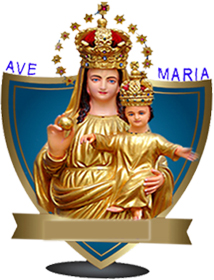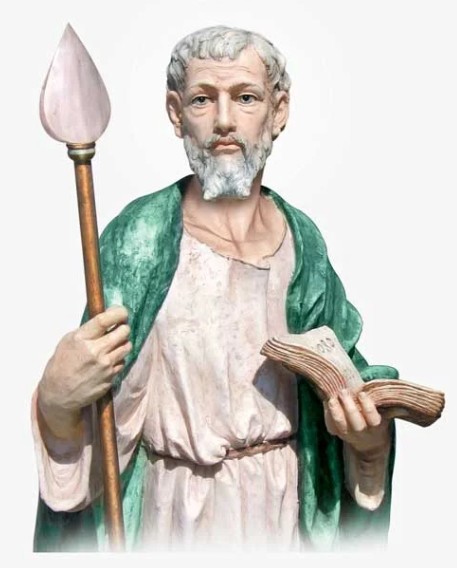


OUR LADY OF SNOWS - PRAY FOR US | புனித தஸ்நேவிஸ் மாதாவே - எங்களுக்காக வேண்டிகொள்ளுங்கள்
St. Thomas: Apostle of India and Founder of Early Churches
Ecclesiastical Presence
According to Tradition St. Thomas, one of the Twelve Apostles of Jesus Christ, had journeyed East and arrived on the South West of India. He established seven churches. One is in Thiruvithancode which is 15 k.m., away from Kottar. Finally he went to Mylapore (Madras). Wherein he introduced Christianity and its tradition in Mylapore and its suburbs. He was martyred at St.Thomas Mount near Mylapore in 72 A.D. and his remains were buried at Mylapore in the sepulcher which lies in the Santhome Basilica, Madras.
Saint Thomas the Apostle, revered as "The Apostle of India," is traditionally believed to have introduced Christianity to the Indian subcontinent in the 1st century AD. His missionary endeavors are chronicled in both historical texts and local traditions, highlighting his profound impact on the spiritual landscape of India.
Thiruvithamcode Arappally (St. Mary's Church)
Believed to be one of the oldest church structures in the world, traditionally founded by St.Thomas around AD 63 in Thiruvithamcode, Kanyakumari district. Known locally as Thomayar Kovil or Arappally, featuring ancient stone walls and a cross allegedly carved by the apostle himself and still in use, it stands as a pilgrimage site and local heritage church
St. Thomas, one of Jesus's Twelve Apostles, ventured east and arrived on the southwestern coast of India in the first century AD . His mission marked the beginning of Christianity in the Malabar and Tamil regions.
Established "Ezharappallikal" — The Seven and a Half Churches
- According to the Acts of Thomas, he landed in Muziris (near modern Kodungallur) circa AD 52, founding seven major Christian communities: Kodungallur, Palayoor, Paravur (Kottakkavu), Kokkamangalam, Niranam, Nilackal, Kollam — the famed Ezharappallikal .
- Continuing his mission, St. Thomas traveled to Thiruvithancode (about 15 km from Kottar in Kanyakumari district), where tradition holds he established Thiruvithamcode Arappally (St. Mary's Church), possibly as early as AD 63 .
- He later journeyed to Mylapore (Madras), where he preached, was martyred at St. Thomas Mount in AD 72, and interred at the site that became Santhome Basilica .
✅ Churches built by Apostle St Thomas
| Church Name & Location | Year Established | Significance |
|---|---|---|
| Kodungallur (Maliankara) | AD 52 | The first church founded around AD 52 at the Muziris port area on Kerala's coast. |
| Palayoor | AD 52 | Built circa AD 52, where St.Thomas famously performed a miracle before converting local Jews and Brahmins. |
| Paravur (Kottakkavu) | AD 52 | Founded in AD 52, known for the ancient granite Persian Cross and close ties to the East Syriac tradition |
| Kokkamangalam | AD 52 | Established in AD 52, reputedly converting around 1,600 people and installing a cross—its relic now housed at Pallippuram. |
| Niranam | AD 54 | Founded about AD 54; the current St.Mary's Orthodox Church claims direct continuity with the original community. |
| Nilackal | AD 52 | Set up around AD 54 in the Western Ghats trade route; ruins and heritage echo its ancient origin. |
| Kollam | 1st century | A major port church, possibly established in the 1st century and later rebuilt—again marking St.Thomas's mission. |
| Thiruvithamkode | AD 63 | Believed to be one of the oldest church structures in the world, traditionally founded by St.Thomas around AD 63 in Thiruvithamcode, Kanyakumari district. Known locally as Thomayar Kovil or Arappally, featuring ancient stone walls and a cross allegedly carved by the apostle himself and still in use, it stands as a pilgrimage site and local heritage church. |
| Church Name & Location | Significance |
|---|---|
| Thiruvithamcode Arappally | Believed to be one of the world's oldest churches; local lore credits the cross to St. Thomas. |
| Sokkankudieruppu (Maravankudieruppu region) | Site where he built a palm-leaf church on land granted by a Pandya king, later buried by red sands and rediscovered, becoming the Athisaya Manal Matha Shrine . |
Thiruvithamcode Arappally (St. Mary's Church)
Believed to be one of the oldest church structures in the world, traditionally founded by St.Thomas around AD 63 in Thiruvithamcode, Kanyakumari district. Known locally as Thomayar Kovil or Arappally, featuring ancient stone walls and a cross allegedly carved by the apostle himself and still in use, it stands as a pilgrimage site and local heritage church.
Athisaya Manal Matha ("Our Lady of Red Sands" Shrine)
- ✅ Named for the red sand that once covered the church, the Athisaya Manal Matha Shrine correlates to the tradition of a buried palm-leaf church believed to date to the 1st century AD .
- ✅ Rediscovered in 1798 under a sand hill, the shrine contains relics like a sacred wooden statue of the Virgin Mary and a memorial cross dated to St. Thomas's era .
- ✅ Today it remains a popular pilgrimage site within the Tuticorin Diocese, honored as a living monument to St. Thomas's influence.
Maravankudieruppu's St. Thomas Legacy
In the region connected to Thurai Thattu near Maravankudieruppu, a site known as Kurusady Thattu once held a revered St. Thomas Cross, where coastal and Pandya Christian traders worshipped under a thatched shed
This locale functioned as an early place of Christian worship and pilgrimage, anchoring the faith in the Venad/Ezhasa Naadu-Pandya socio-cultural setting.
Mission in the Southern Pandya Kingdom
Local traditions in Tamil Nadu recount Saint Thomas's journey to the southern Pandya kingdom, ruled by King Kandappa Rasa. The king, afflicted by ailments, sought Saint Thomas's healing powers. Upon being cured, Kandappa Rasa embraced Christianity and was baptized as "Sabor." In gratitude, he granted Saint Thomas three cents of land in Sokkankudieruppu, near Thiruchendur, to establish a church dedicated to the Virgin Mary. This church, constructed with palm leaves, is believed to be the first Christian church built on Indian soil
Rediscovery of Athisaya Manal Matha Shrine
The Athisaya Manal Matha Shrine, dedicated to Our Lady of Snows, is located in the village of Sokkankudieruppu. This shrine is believed to have been established by Saint Thomas himself. Over the centuries, it has become a significant pilgrimage site for Christians in the region. The shrine was rediscovered in the 20th century and has since been a focal point for the local Christian community, attracting devotees from far and wide.
Over time, the original church was buried under red sand due to a catastrophic sandstorm, which local lore attributes to divine retribution for injustices in the kingdom. In 1798, a shepherd boy discovered remnants of the church, leading to its excavation and restoration. Today, the site is known as the Athisaya Manal Matha Shrine or "Our Lady of Red Sands." The shrine houses a statue of the Virgin Mary, believed to be made from a blend of sandalwood and elephant tusk, and is a significant pilgrimage center in the Diocese of Tuticorin
🧭Archaeological Rediscovery
Excavations in 1798-99 at the red sand dune in Sokkankudieruppu (ancient Kanakkankudieruppu, part of Maanaveera Naadu) uncovered an underground church dedicated to the Virgin Mary, along with a wooden statue—believed to date back to the 1st century AD during St. Thomas's time.
✝️St Thomas in Chennai
St. Thomas's journey to Chennai (Mylapore) is believed to have occurred after his missionary work in Kerala, where he founded the seven churches. He arrived in Mylapore around AD 68-70, continuing his mission to spread Christianity among the local population.
In Mylapore, St. Thomas preached, converted many locals, and performed miracles. His presence in the region is commemorated by the Santhome Cathedral Basilica, which is built over his burial site.
St.Thomas was buried by disciples in Mylapore, over whose remains the Santhome Cathedral Basilica arose.
Tomb at Santhome: Tradition maintains that after his martyrdom on the Mount in AD 72, his disciples buried him in Mylapore, where they built a memorial church in his honor
Portuguese Rebirth: The original structure fell into ruin until Portuguese missionaries rediscovered and rebuilt it in 1523 as Santhome Church, later elevated to a cathedral in 1606 and designated a Minor Basilica in 1956
Holy Relics: The tomb is located beneath the basilica's smaller central tower; relics include a bone fragment and the spearhead (lance) believed to have killed St.Thomas
⛰ Little Mount (Chinnamalai) - Thomas' Refuge & Miracles
Historical Refuge: A small hillock near Saidapet where St. Thomas is traditionally believed to have lived in a natural cave while fleeing persecution in the late 1st century AD
St. Thomas Cave: Little Mount was construted in 1551 by Portuguese as chapel of (Our Lady of Good Health), the cave contains his reputed hand and footprint impressions and a carved cross
Bleeding Cross: A cross chiselled into a rock that miraculously bled from 1561 to 1700
🗡️ Martyrdom at St. Thomas Mount (Parangimalai)
Martyrdom Site: According to Syrian Christian and Latin tradition, St. Thomas was martyred at St.Thomas Mount by a lance during prayer, either AD 72 (Syrian tradition) or on December 21 (Latin tradition)
Our Lady of Expectation Shrine: Built in 1523 by the Portuguese, it marks the precise spot of his martyrdom atop the mount, reached by 160+ steps funded by Armenian merchant Petrus Uscan; arches at the foothill date to 1547
Everlasting Legacy: The mount remains a major pilgrimage site with relics such as the bleeding cross, chapel, and the devotional Stations of the Cross lining the pilgrim path
source 1: A New Discovery on the First Mission of St. Thomas by Rev Fr Pancras M Raja
2. Alex Cruz Muthaiah (1995) in his research book called "Maanaveera Naadu of the Southern Pandian Kingdom" Alex Cruz Muthaiah
